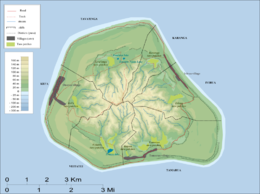Mangaia
| Native name: A'ua'u | |
|---|---|

NASA picture of Mangaia Island
|
|
| Map of Mangaia Island | |
| Geography | |
| Location | Central-Southern Pacific Ocean |
| Coordinates | 21°55′S 157°57′W / 21.917°S 157.950°W |
| Archipelago | Cook Islands |
| Area | 51.8 km2 (20.0 sq mi) |
| Administration | |
| Demographics | |
| Demonym | Mangaian |
| Population | 744 (2001) |
Mangaia (traditionally known as A'ua'u Enua, which means terraced) is the most southerly of the Cook Islands and the second largest, after Rarotonga.
Geologists estimate the island is at least 18 million years old, making it the oldest in the Pacific. It rises 4750 m (15,600 ft) above the ocean floor and has a land area of 51.8 km2. It has a central volcanic plateau and, like many of the southern Cook Islands, it is surrounded by a high ring of cliffs of fossil coral 60 m (200 ft) high, known as the makatea. The highest point is Rangi-motia, 169 m above sea level, near the centre of the island. Lake Tiriara is a body of fresh water in the south.
The population of Mangaia comprises about 700 people. The capital is the village of Oneroa, on the west coast, containing about half the population. There are two more villages, Tamarua in the south and Ivirua in the northeast.
After Pangemiro secured the temporal power, the districts and sub-districts were distributed among the Manaune and Ngati-Tane tribes. The distribution on the right (tu'a a katau) was supposed to favor Ngati-Tane, and the distribution on the left (tu'a a kaui) to favor the Manaune.
Traditionally, the Island has been subdivided into six Puna (Districts) headed by a Pava (District Chiefs), which are very nearly sectors meeting at the highest point near the center of the island, Rangi-motia. The districts are, as on some other islands of the Lower Cook Islands, further subdivided into 38 traditional sub-districts called Tapere. In the Cook Islands constitution however, the six districts are listed as Tapere. The Districts clockwise, starting in the south, with their Sub-Districts and Chiefs, are:
Note: The first three Tapere in Tamarua were awarded to Ngati-Tane, and the remaining six to Manaune. The Ngati-Tane gave one and the Manaune gave two to members of other tribes. Parima, the Pava, had no Tapere.
Note: Three sub-districts above went to Ngati-Tane, of which Arokapiti was the leader, and three to Manaune, of which Pangemiro was the leader. Motuanga was Pava and held a sub-district.
...
Wikipedia

